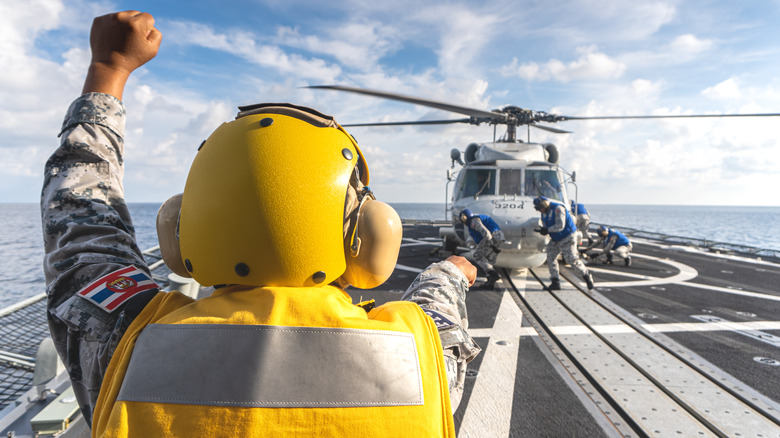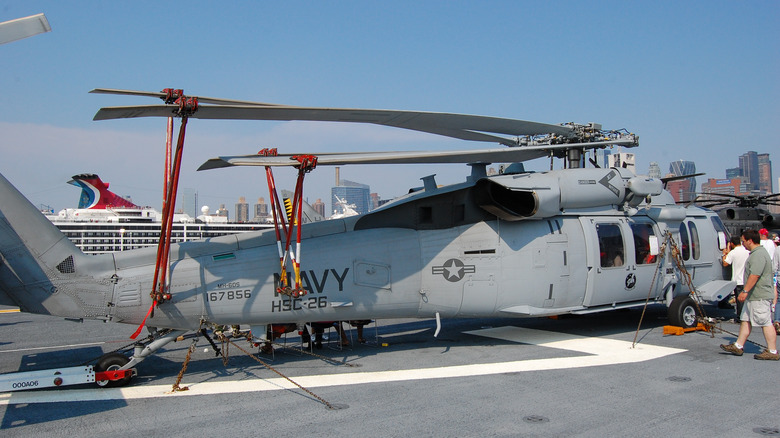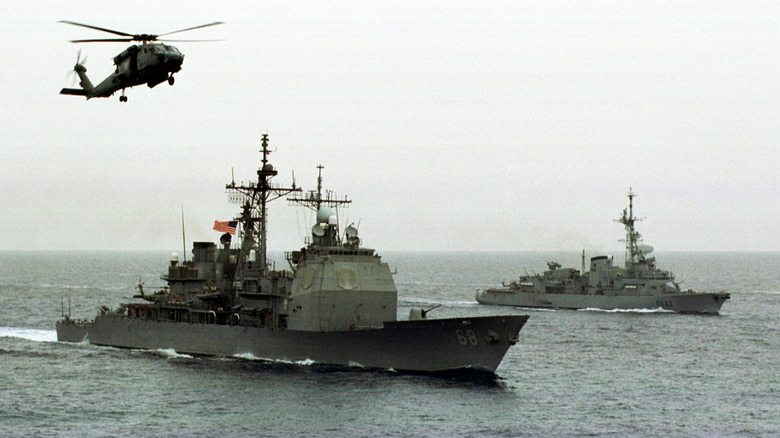MH-60 Seahawk: What Makes The US Navy's Black Hawk Cousin Unique
Originally built as a naval adaptation of the UH-60 Black Hawk, the MH-60 Seahawk has evolved into a helicopter uniquely designed for maritime operations. There are a lot of things special about the Black Hawk, so it's a great foundation to build upon, and the MH-60 variant does just that. The Seahawk retains the H-60 family's standard dimensions of 64 feet 10 inches with a 53-foot 8-inch main rotor, in addition to extensive structural modifications to meet shipboard requirements. On destroyers, frigates, and other vessels, the Seahawk is equipped with foldable main rotor blades and a hinged tail to occupy as little storage space as possible, and its landing gear consists of a conventional tailwheel layout.
However, to enhance deck handling and stability in rough seas, the MH-60R variant tail wheel is moved forward on the fuselage, shortening the wheelbase. The Seahawk's airframe also uses specialized anti-corrosion coatings to protect it against the constant exposure to saltwater and high humidity, which could compromise the helicopter's fuselage. The MH-60 Seahawk is unique because of these modifications, and they enable it to operate safely on confined decks while supporting high-intensity missions, making the difference clear from its land-based cousin, defining the Seahawk's identity as a dedicated naval helicopter.
Power, propulsion, and reliability at sea
The MH-60 is one of the many military helicopters Sikorsky makes, pushing helicopter technology forward. A big part of the Seahawk's naval modifications is to its propulsion and electrical systems. The twin T700-GE-401C or 401D engines are capable of producing around 1,940 shaft horsepower and are also optimized to resist corrosion, erosion, and the harsh effects of maritime operations, just like the helicopter's exterior. Other key improvements include modified compressor blades and hot-section durability enhancements to ensure tip-top performance in conditions where salt and humidity are huge factors, that can certainly destroy machines and equipment over time.
To combat this, the Seahawk features a triple-redundant electrical system: two main generators driven by the engines and a dedicated auxiliary power unit to make sure advanced sensors and critical systems are always online to support energy-intensive mission equipment such as dipping sonar, radar, and folding mechanisms. This is even when the main engines are off. Its structural toughness comes down to dual-redundant flight controls, modular transmissions, and rotor blades capable of withstanding ballistic impact, making it always available and the most reliable helicopter in its class.
Specialized roles, Romeo and Sierra variants
The Seahawk program is split into two specialized variants: the MH-60R "Romeo" and MH-60S "Sierra." The Navy's multi-mission combat helicopter is the Romeo, equipped for anti-submarine warfare, anti-surface warfare, and electromagnetic operations. It has high-tech sensors, including sonar that dips into the water and radar that scans the surface, letting it find, track, and identify threats both underwater and at sea level. The Romeo variant can carry torpedoes, missiles, and crew-served guns, ensuring full combat capability while maintaining high mission readiness. The Sierra operates as a utility and support helicopter, focusing on fleet logistics, vertical replenishment, search and rescue, and Airborne Mine Countermeasures.
Its modular design makes rapid reconfiguration for specialized tasks easy, including towing mine detection sensors or neutralizers. Although it can carry defensive armaments for certain missions, its primary purpose is operational support rather than front line combat. Both the Romeo and Sierra variants allow the MH-60 family to cover the full spectrum of naval missions, combining high-intensity combat capability with essential logistical and specialized maritime support.


